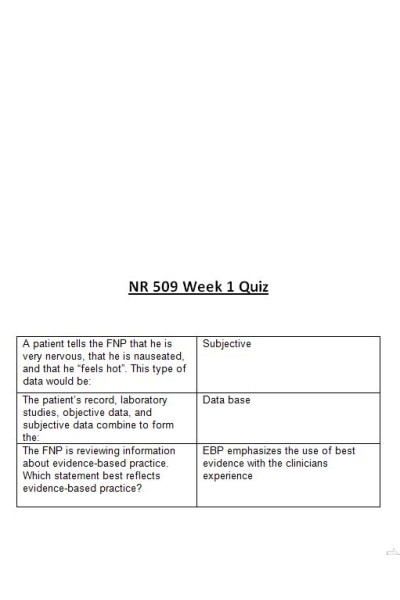1. A
patient tells the FNP that he is very nervous, that he is nauseated, and that
he “feels hot”. This type of data would be:
2. The
patient’s record, laboratory studies, objective data, and subjective data
combine to form the:
3. The
FNP is reviewing information about evidence-based practice. Which statement
best reflects evidence-based practice?
4. A
59-year-old patient tells the FNP that he has ulcerative colitis. He has been
having black stools for the last 24 hours. How would the FNP best document his
reason for seeking care?
5. A
29-year-old woman tells the FNP that she has excruciating pain in her back.
Which would be an appropriate response by the FNP to the woman statement?
6. In
recording the childhood illnesses of a patient who denies having had any, which
note by the FNP would be most accurate?
7. If
a female patient tells the FNP that she has had six pregnancies, with four live
births at term and two spontaneous abortions. Her four children are still
living. How would the FNP record this information?
8. If
a female patient tells the FNP that she has had six pregnancies, with four live
births at term and two spontaneous abortions. Her four children are still
living. How would the FNP record this information?
9. Which
of these statements represents subjective data the FNP obtained from the
patient regarding the patient’s skin?
10. The
FNP is obtaining a history for a 30-year-old male patient and is concerned
about health promotion activities. Which of these questions would be
appropriate to use to assess health promotion activities for this patient?
11. Which
statement indicates that the FNP understands the pain experienced by an elderly
person?
12. The
FNP is performing a vision examination. Which of these charts is most widely
used for visual examination?
13. During
a complete health assessment, how would the FNP test the patients hearing?
14. The
FNP has just completed an examination of a patient’s extra-ocular muscles. When
documenting the findings, the FNP should document the assessment of which
cranial nerves?
15. A
patient’s uvula rises midline when she says “ahh” and she has a positive gag
reflex. The FNP has just tested which cranial nerve?
16. During an examination the FNP notices that a patient is unable to stick out his tongue. Which cranial nerve is involved with successful performance of this action?
17. A
patient is unable to shrug her shoulders against the FNP‘s resistant hands.
What cranial nerve is involved with successful shoulder shrugging?
18. During
an examination, the patient has just successfully completed the finger to nose
and rapid alternating movements test and is able to run each heel down the
opposite shin. The FNP would conclude that the patient’s___ function is intact
19. A
five-year-old child is in the clinic for checkup. The FNP would expect him to:
20. When
the FNP performs the confrontation test the FNP has assessed:
21. Which
of these statements is true regarding the complete physical assessment?
22. Which
of these statements is true regarding recording of data from the history and
physical examination?
23. Which
of these is included in assessment of general appearance?
24. The
FNP is performing a review of symptoms. Which of these questions are
appropriate as Health promotion questions to ask during this time?
25. The
FNP is incorporating a person’s spiritual values into the health history. Which
of these questions illustrates the community portion of the FICA questions?
26. The
FNP is preparing to complete a health assessment on a 16-year-old girl whose
parents have brought her to the clinic. Which instruction would be appropriate
for the parents before the interview begins?
| Instituition / Term | |
| Term | Spring Session |
| Institution | Chamberlain |







-80x80.JPG)





































